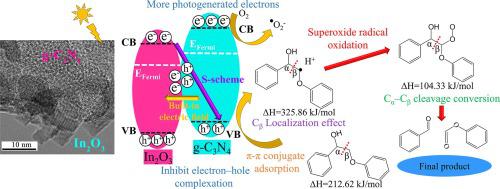当前位置:
X-MOL 学术
›
J. Colloid Interface Sci.
›
论文详情
Our official English website, www.x-mol.net, welcomes your
feedback! (Note: you will need to create a separate account there.)
S-scheme electron transfer promoted by novel indium oxide quantum dot–loaded carbon nitride heterojunctions promoted using oxidized indium monomers
Journal of Colloid and Interface Science ( IF 9.4 ) Pub Date : 2024-04-27 , DOI: 10.1016/j.jcis.2024.04.192 Xiang Li 1 , Yunyi Wang 2 , Ting Wu 1 , Guigan Fang 3
Journal of Colloid and Interface Science ( IF 9.4 ) Pub Date : 2024-04-27 , DOI: 10.1016/j.jcis.2024.04.192 Xiang Li 1 , Yunyi Wang 2 , Ting Wu 1 , Guigan Fang 3
Affiliation

|
The graphitic carbon nitride (g-CN) photocatalysis has emerged as a clean method for cleaving lignin-linked bonds due to its mild and sunlight-driven reaction conditions. The fast electron–hole pair complex of g-CN constrains its degradation efficiency, making the heterojunction construction a popular solution. The conventional methods of preparing g-CN heterojunctions by physical mixing destroy π-conjugations in g-CN, reducing the adsorption of lignin containing benzene rings. In this study, a novel indium oxide (InO) quantum dot–g-CN 0D/2D heterojunction was prepared through the high-temperature oxidation of pre-prepared indium-doped g-CN. The introduction of InO at the quantum dot level minimizes the interference with lignin adsorption capacity. The strong combination of the two (InO and g-CN) increases the intersection interface area, promoting the S-scheme transfer route of the photogenerated electrons. Consequently, this enhances the photoelectric conversion efficiency and carrier lifetime of the heterojunction, and inhibits the rapid recombination of photogenerated electron–hole pairs in g-CN. The proposed heterojunction was 3 times more efficient than g-CN alone for selective cleavage of lignin β–O–4 bonds after 2 h of sunlight irradiation. Combined with inhibitor experiments and gas chromatography–mass spectrometry analysis, this paper defines the reactive oxides and proposes a cleavage pathway for the lignin β–O–4 bonds in InO–g-CN heterojunction system.
中文翻译:

使用氧化铟单体促进新型氧化铟量子点负载氮化碳异质结促进S型电子转移
石墨氮化碳(g-CN)光催化由于其温和且由阳光驱动的反应条件而成为一种裂解木质素连接键的清洁方法。 g-CN 的快速电子空穴对复合物限制了其降解效率,使得异质结结构成为一种流行的解决方案。传统的物理混合制备g-CN异质结的方法破坏了g-CN中的π共轭性,降低了对含苯环木质素的吸附。在这项研究中,通过对预先制备的铟掺杂g-CN进行高温氧化,制备了一种新型氧化铟(InO)量子点-g-CN 0D/2D异质结。在量子点水平上引入 In2O 可以最大限度地减少对木质素吸附能力的干扰。两者(InO和g-CN)的强结合增加了交叉界面面积,促进了光生电子的S型传输路径。因此,这提高了异质结的光电转换效率和载流子寿命,并抑制了g-CN中光生电子空穴对的快速复合。所提出的异质结在阳光照射 2 小时后选择性裂解木质素 β-O-4 键的效率比单独的 g-CN 高 3 倍。结合抑制剂实验和气相色谱-质谱分析,本文定义了活性氧化物,并提出了InO-g-CN异质结体系中木质素β-O-4键的裂解途径。
更新日期:2024-04-27
中文翻译:

使用氧化铟单体促进新型氧化铟量子点负载氮化碳异质结促进S型电子转移
石墨氮化碳(g-CN)光催化由于其温和且由阳光驱动的反应条件而成为一种裂解木质素连接键的清洁方法。 g-CN 的快速电子空穴对复合物限制了其降解效率,使得异质结结构成为一种流行的解决方案。传统的物理混合制备g-CN异质结的方法破坏了g-CN中的π共轭性,降低了对含苯环木质素的吸附。在这项研究中,通过对预先制备的铟掺杂g-CN进行高温氧化,制备了一种新型氧化铟(InO)量子点-g-CN 0D/2D异质结。在量子点水平上引入 In2O 可以最大限度地减少对木质素吸附能力的干扰。两者(InO和g-CN)的强结合增加了交叉界面面积,促进了光生电子的S型传输路径。因此,这提高了异质结的光电转换效率和载流子寿命,并抑制了g-CN中光生电子空穴对的快速复合。所提出的异质结在阳光照射 2 小时后选择性裂解木质素 β-O-4 键的效率比单独的 g-CN 高 3 倍。结合抑制剂实验和气相色谱-质谱分析,本文定义了活性氧化物,并提出了InO-g-CN异质结体系中木质素β-O-4键的裂解途径。





















































 京公网安备 11010802027423号
京公网安备 11010802027423号